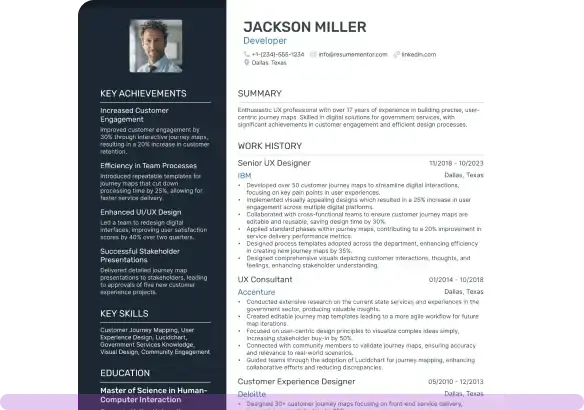Computer Science Resume Examples

Mar 26, 2025
|
12 min read
Crack the code to crafting a standout computer science resume. Learn to debug your skills and experiences, write a clear, concise summary, and loop through effective tips to build your personal algorithm for success.
Rated by 348 people
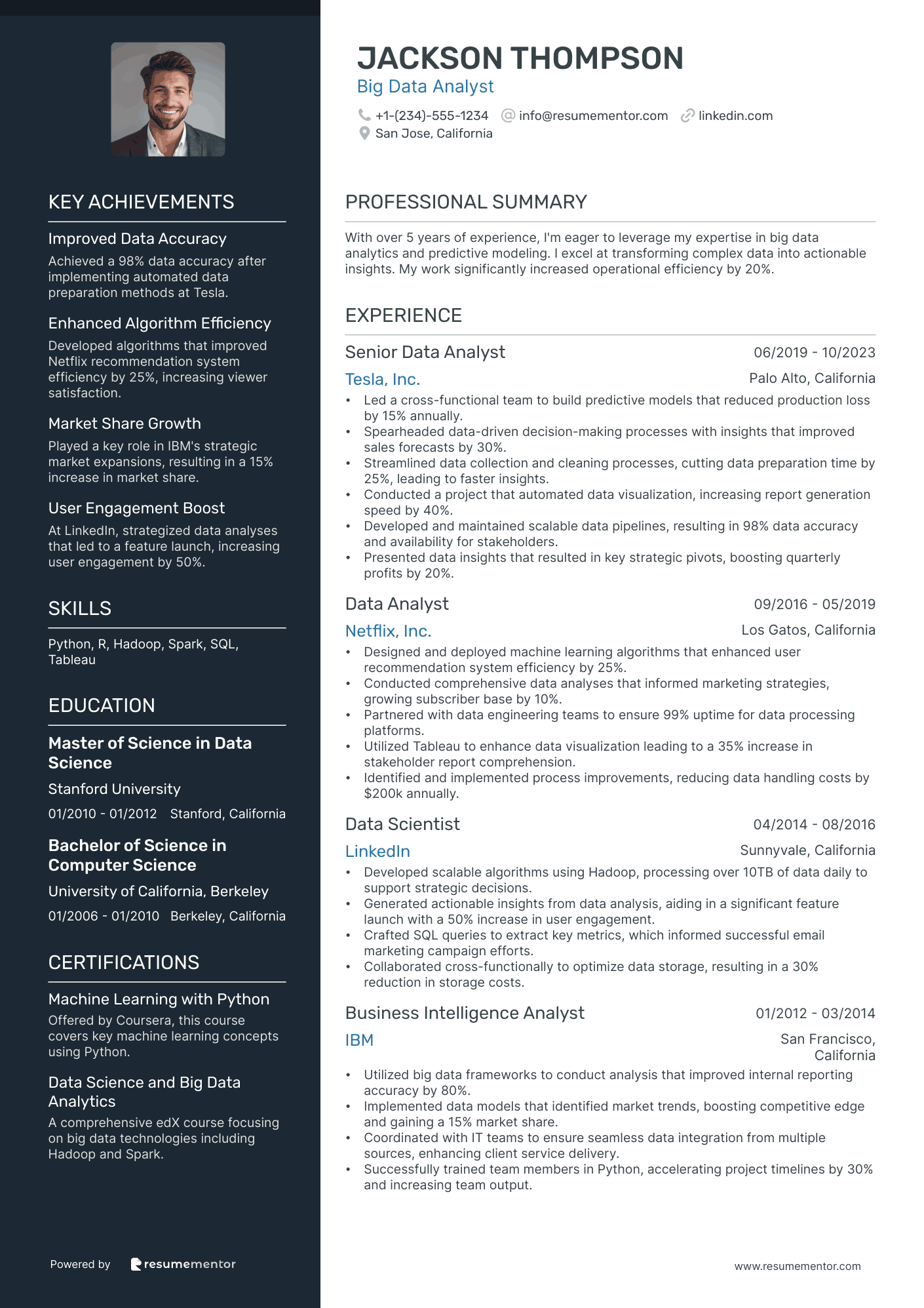
Big Data Analyst
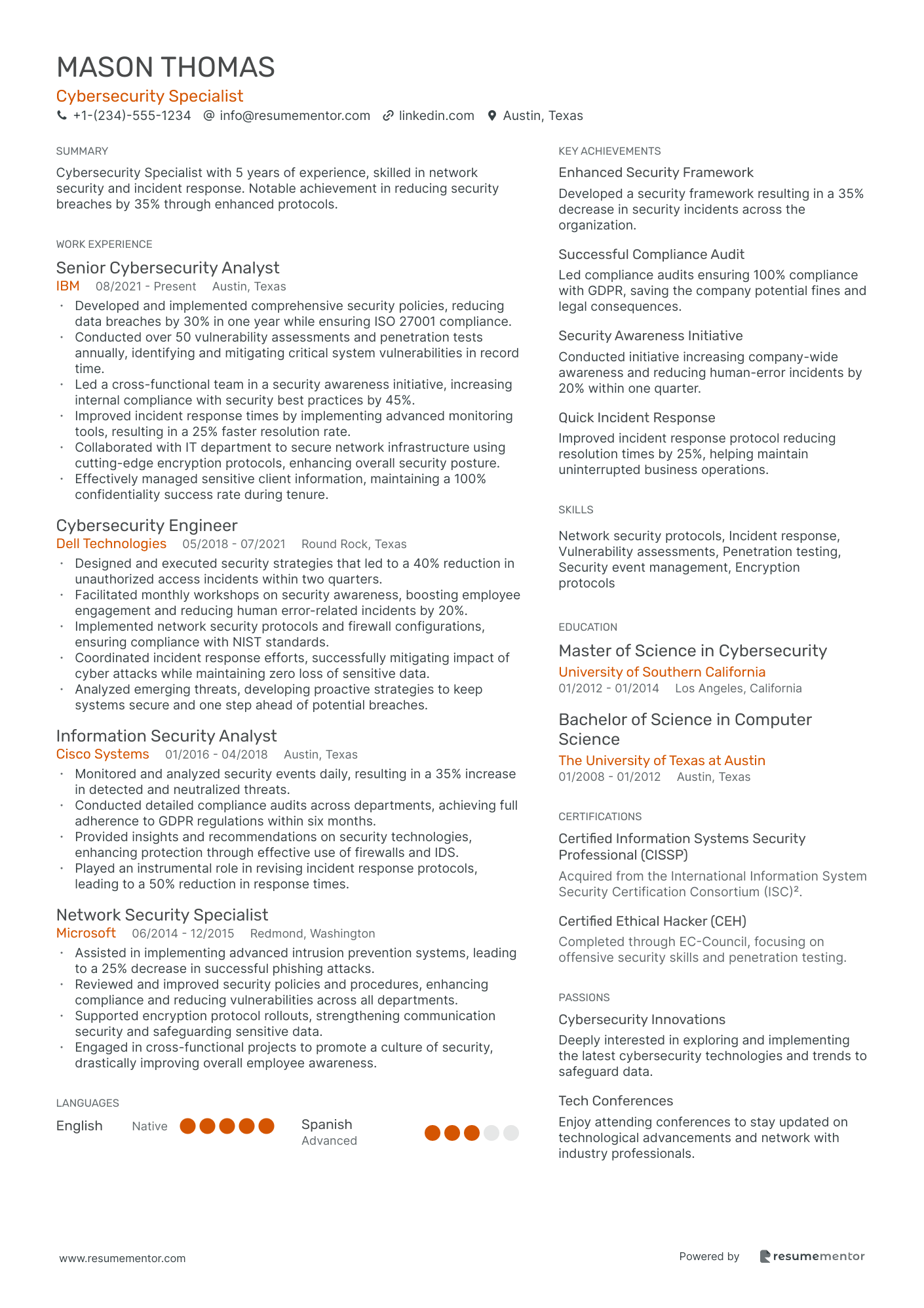
Cybersecurity Specialist
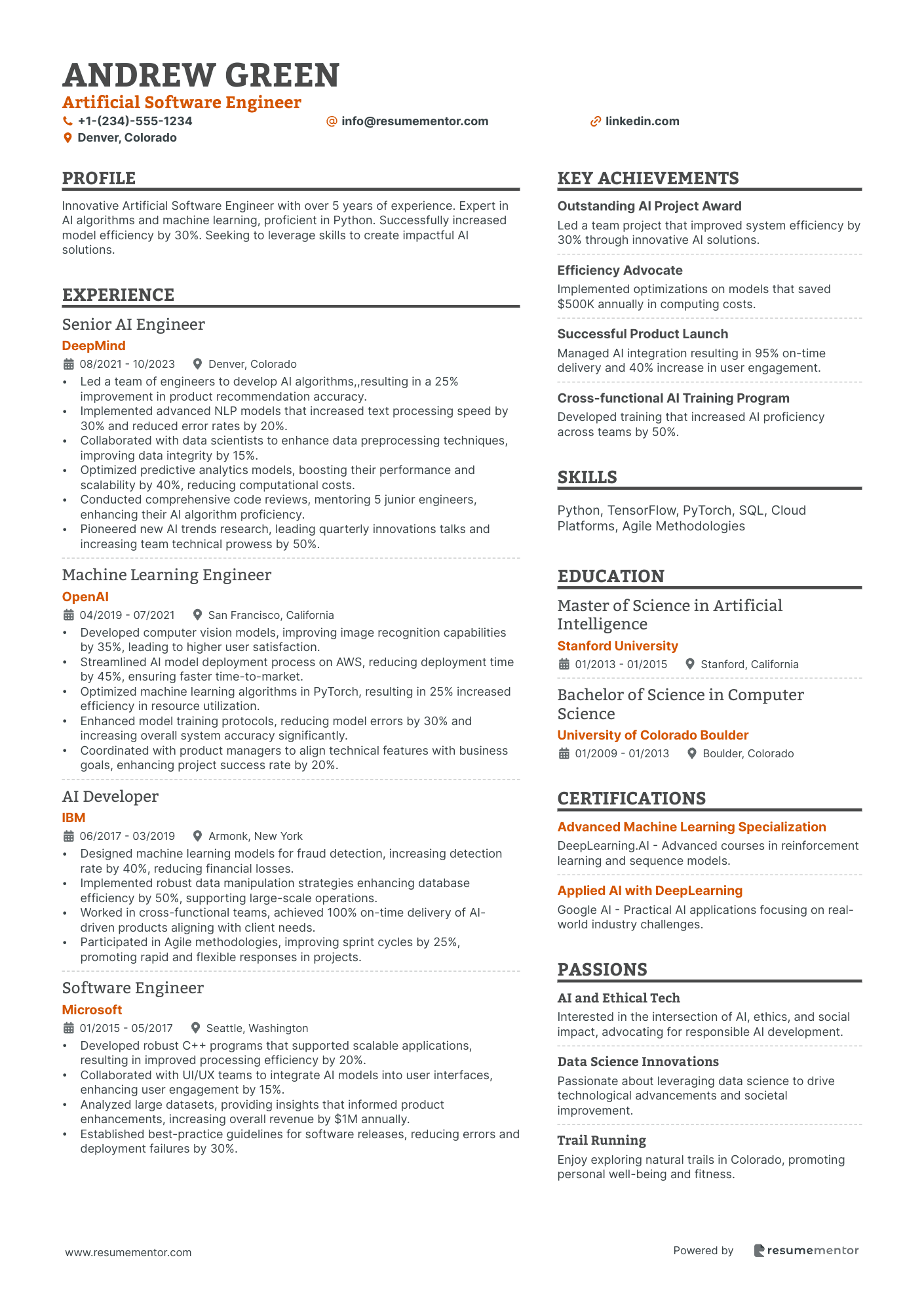
Artificial Software Engineer
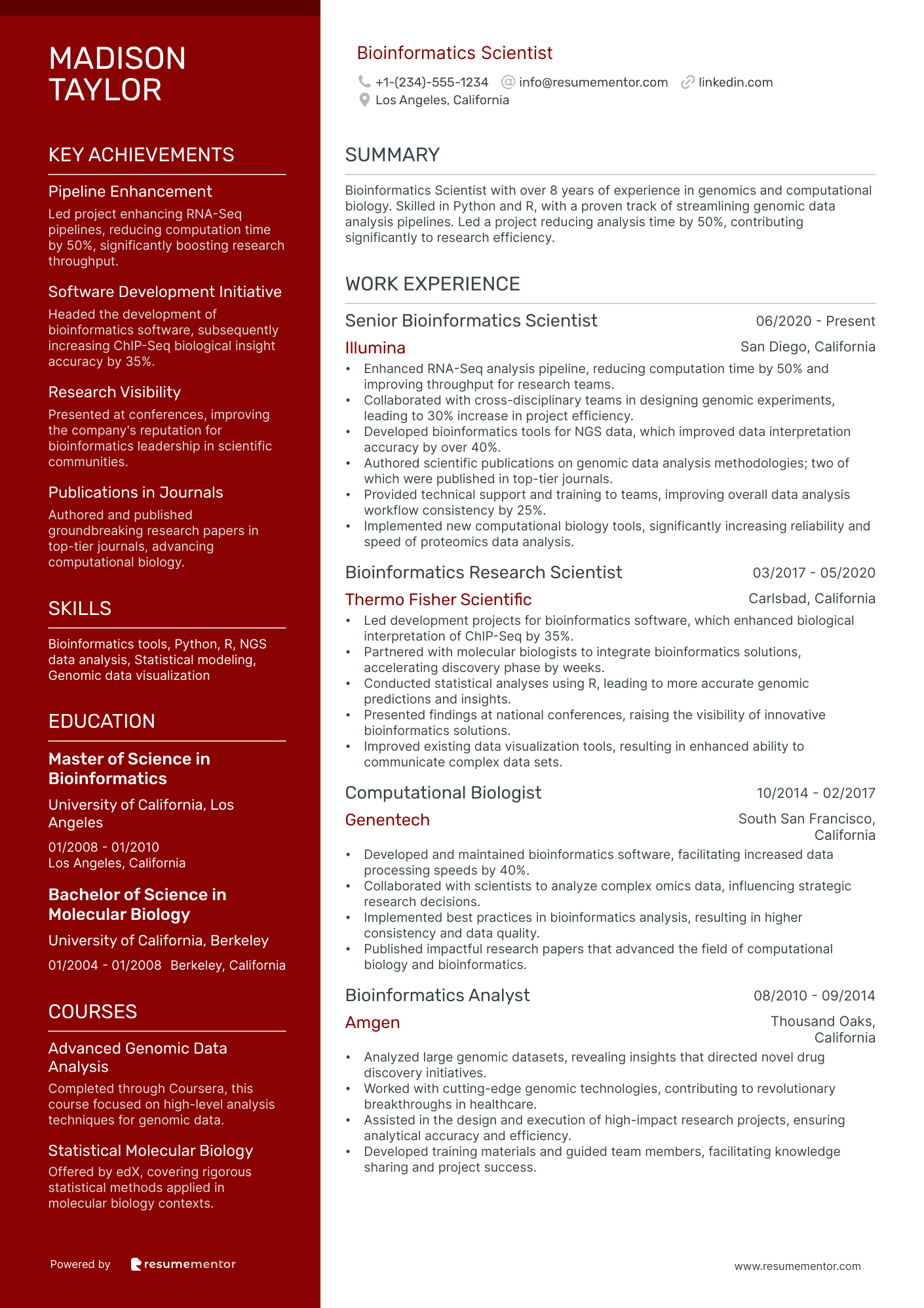
Bioinformatics Scientist
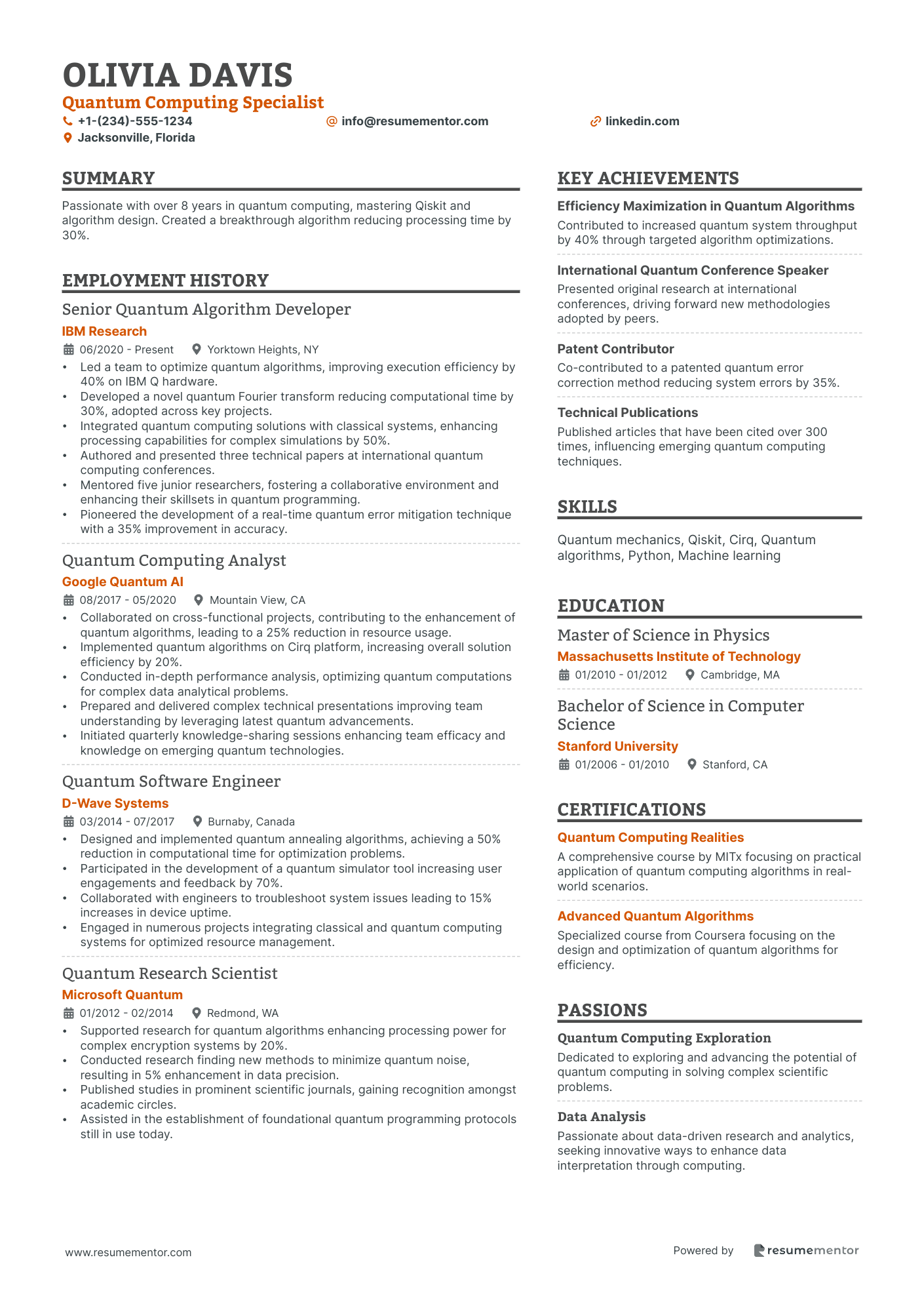
Quantum Computing Specialist
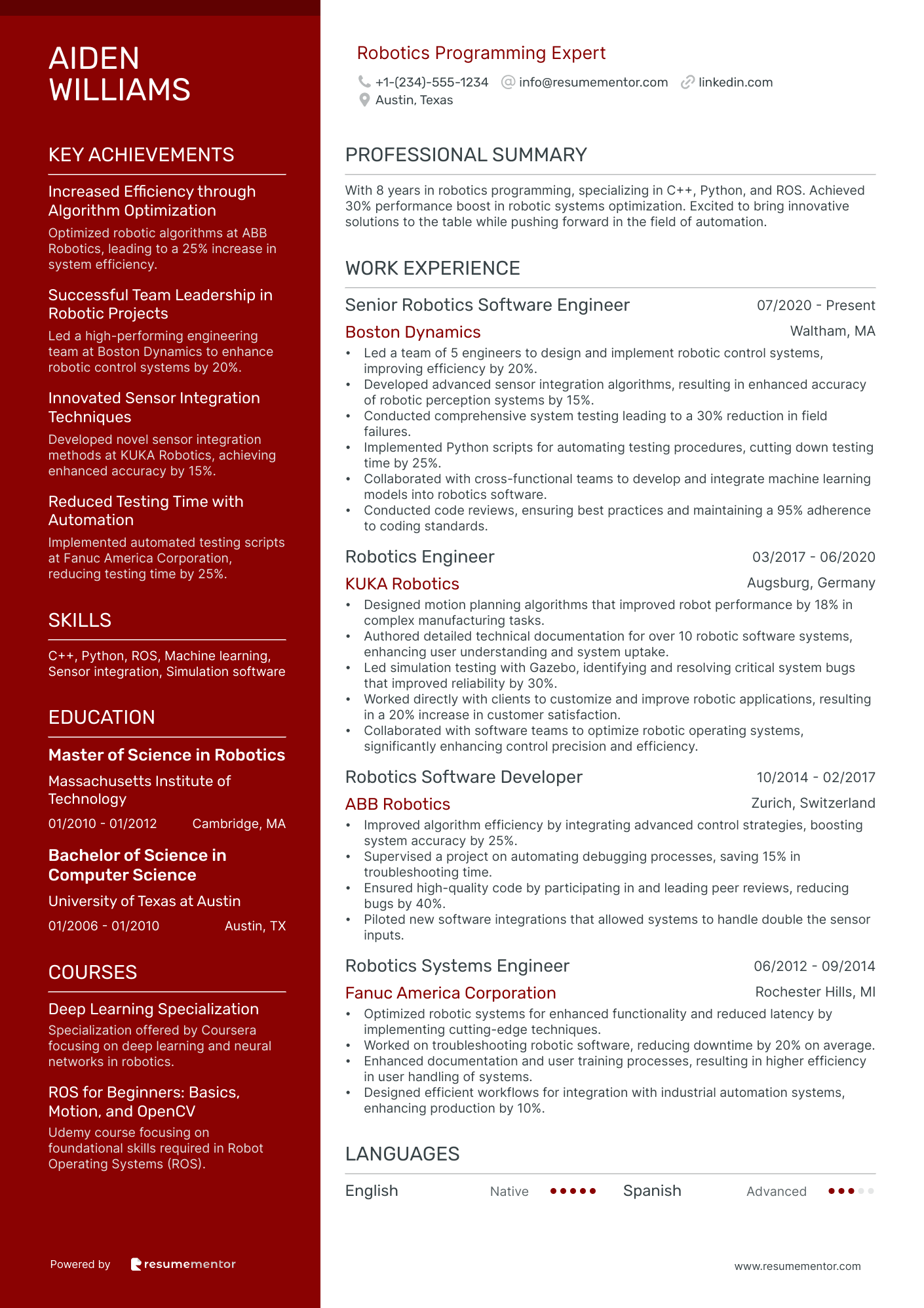
Robotics Programming Expert
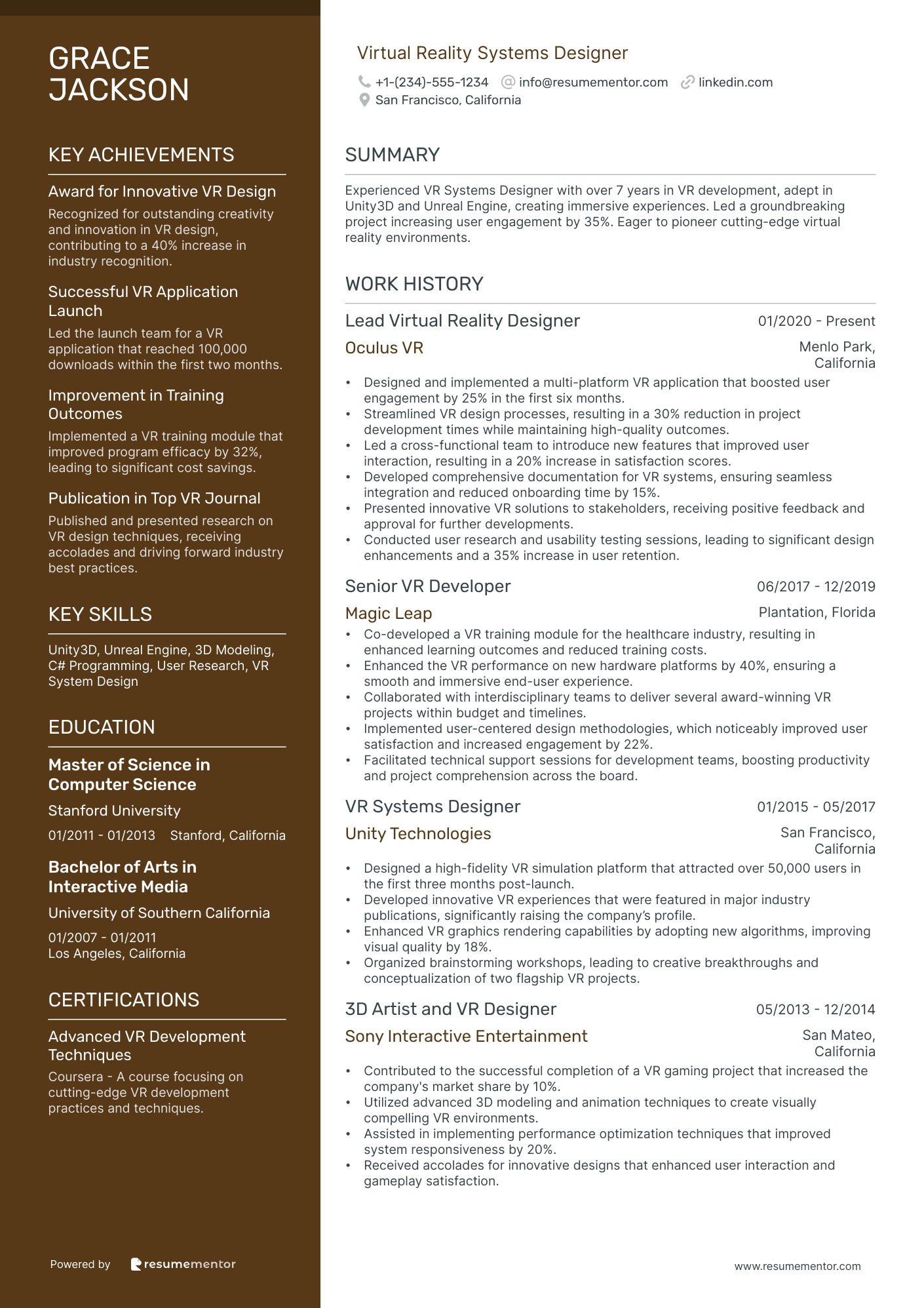
Virtual Reality Systems Designer
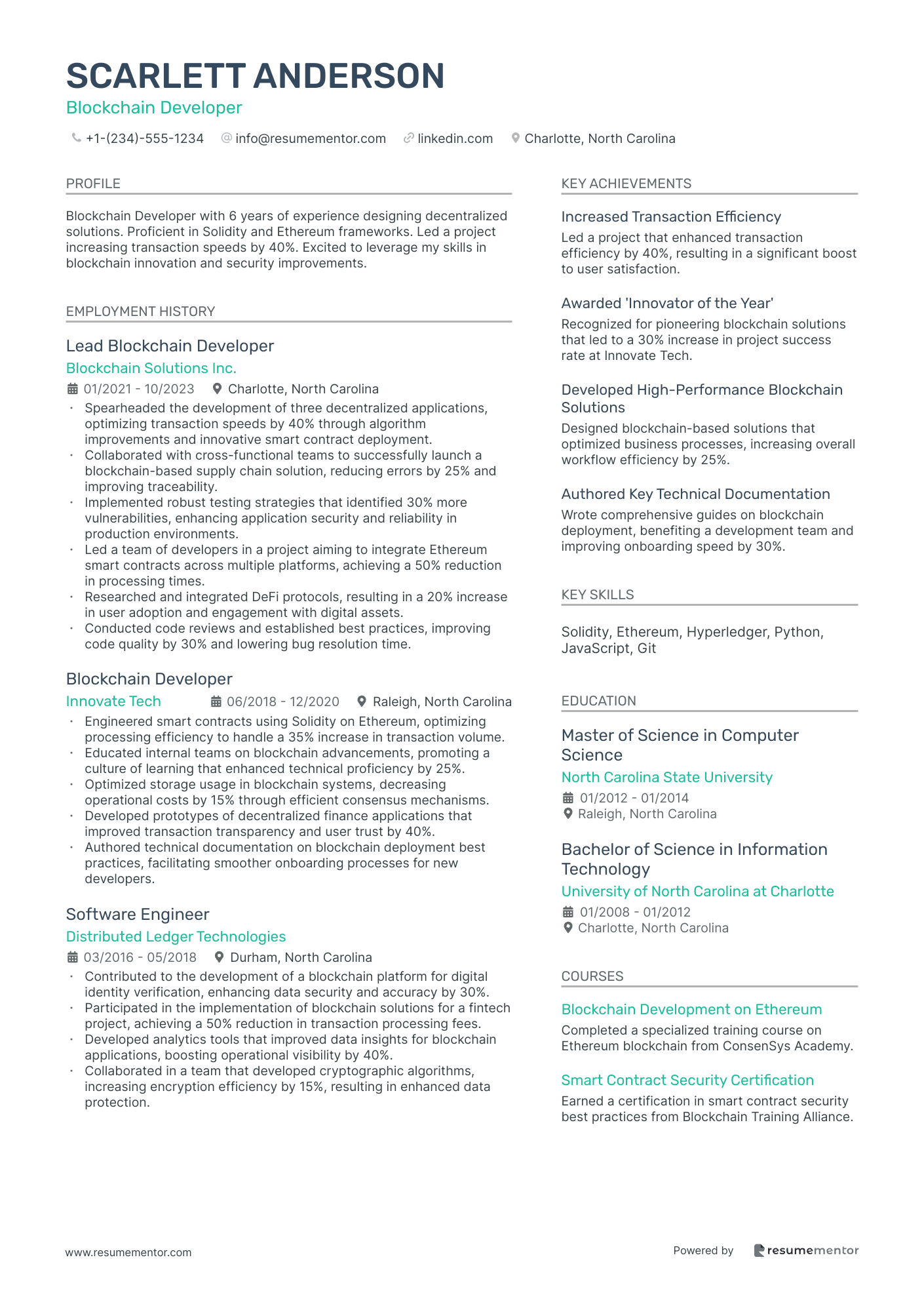
Blockchain Developer
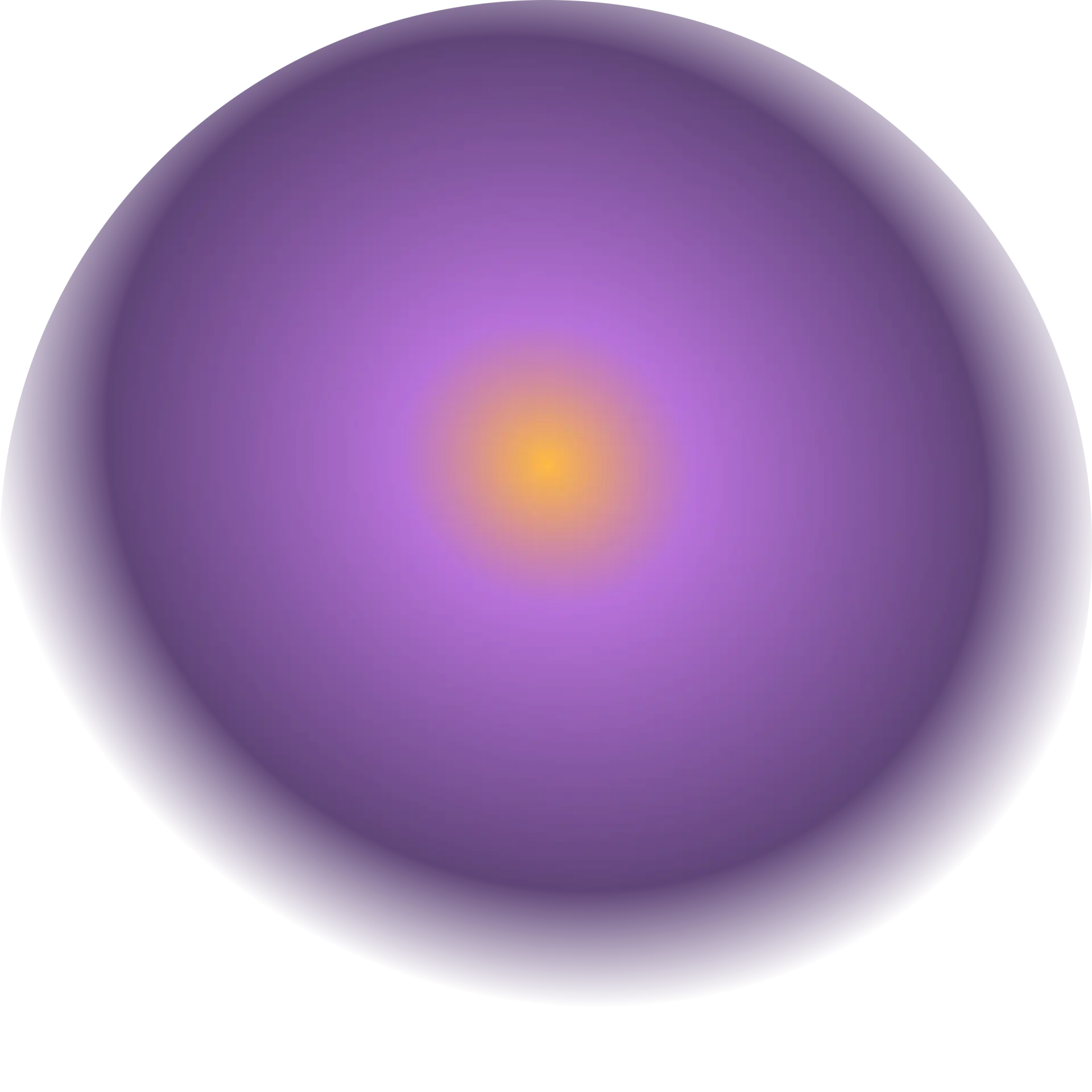
Big Data Analyst resume sample
- •Led a cross-functional team to build predictive models that reduced production loss by 15% annually.
- •Spearheaded data-driven decision-making processes with insights that improved sales forecasts by 30%.
- •Streamlined data collection and cleaning processes, cutting data preparation time by 25%, leading to faster insights.
- •Conducted a project that automated data visualization, increasing report generation speed by 40%.
- •Developed and maintained scalable data pipelines, resulting in 98% data accuracy and availability for stakeholders.
- •Presented data insights that resulted in key strategic pivots, boosting quarterly profits by 20%.
- •Designed and deployed machine learning algorithms that enhanced user recommendation system efficiency by 25%.
- •Conducted comprehensive data analyses that informed marketing strategies, growing subscriber base by 10%.
- •Partnered with data engineering teams to ensure 99% uptime for data processing platforms.
- •Utilized Tableau to enhance data visualization leading to a 35% increase in stakeholder report comprehension.
- •Identified and implemented process improvements, reducing data handling costs by $200k annually.
- •Developed scalable algorithms using Hadoop, processing over 10TB of data daily to support strategic decisions.
- •Generated actionable insights from data analysis, aiding in a significant feature launch with a 50% increase in user engagement.
- •Crafted SQL queries to extract key metrics, which informed successful email marketing campaign efforts.
- •Collaborated cross-functionally to optimize data storage, resulting in a 30% reduction in storage costs.
- •Utilized big data frameworks to conduct analysis that improved internal reporting accuracy by 80%.
- •Implemented data models that identified market trends, boosting competitive edge and gaining a 15% market share.
- •Coordinated with IT teams to ensure seamless data integration from multiple sources, enhancing client service delivery.
- •Successfully trained team members in Python, accelerating project timelines by 30% and increasing team output.
Cybersecurity Specialist resume sample
- •Developed and implemented comprehensive security policies, reducing data breaches by 30% in one year while ensuring ISO 27001 compliance.
- •Conducted over 50 vulnerability assessments and penetration tests annually, identifying and mitigating critical system vulnerabilities in record time.
- •Led a cross-functional team in a security awareness initiative, increasing internal compliance with security best practices by 45%.
- •Improved incident response times by implementing advanced monitoring tools, resulting in a 25% faster resolution rate.
- •Collaborated with IT department to secure network infrastructure using cutting-edge encryption protocols, enhancing overall security posture.
- •Effectively managed sensitive client information, maintaining a 100% confidentiality success rate during tenure.
- •Designed and executed security strategies that led to a 40% reduction in unauthorized access incidents within two quarters.
- •Facilitated monthly workshops on security awareness, boosting employee engagement and reducing human error-related incidents by 20%.
- •Implemented network security protocols and firewall configurations, ensuring compliance with NIST standards.
- •Coordinated incident response efforts, successfully mitigating impact of cyber attacks while maintaining zero loss of sensitive data.
- •Analyzed emerging threats, developing proactive strategies to keep systems secure and one step ahead of potential breaches.
- •Monitored and analyzed security events daily, resulting in a 35% increase in detected and neutralized threats.
- •Conducted detailed compliance audits across departments, achieving full adherence to GDPR regulations within six months.
- •Provided insights and recommendations on security technologies, enhancing protection through effective use of firewalls and IDS.
- •Played an instrumental role in revising incident response protocols, leading to a 50% reduction in response times.
- •Assisted in implementing advanced intrusion prevention systems, leading to a 25% decrease in successful phishing attacks.
- •Reviewed and improved security policies and procedures, enhancing compliance and reducing vulnerabilities across all departments.
- •Supported encryption protocol rollouts, strengthening communication security and safeguarding sensitive data.
- •Engaged in cross-functional projects to promote a culture of security, drastically improving overall employee awareness.
Artificial Software Engineer resume sample
- •Led a team of engineers to develop AI algorithms,,resulting in a 25% improvement in product recommendation accuracy.
- •Implemented advanced NLP models that increased text processing speed by 30% and reduced error rates by 20%.
- •Collaborated with data scientists to enhance data preprocessing techniques, improving data integrity by 15%.
- •Optimized predictive analytics models, boosting their performance and scalability by 40%, reducing computational costs.
- •Conducted comprehensive code reviews, mentoring 5 junior engineers, enhancing their AI algorithm proficiency.
- •Pioneered new AI trends research, leading quarterly innovations talks and increasing team technical prowess by 50%.
- •Developed computer vision models, improving image recognition capabilities by 35%, leading to higher user satisfaction.
- •Streamlined AI model deployment process on AWS, reducing deployment time by 45%, ensuring faster time-to-market.
- •Optimized machine learning algorithms in PyTorch, resulting in 25% increased efficiency in resource utilization.
- •Enhanced model training protocols, reducing model errors by 30% and increasing overall system accuracy significantly.
- •Coordinated with product managers to align technical features with business goals, enhancing project success rate by 20%.
- •Designed machine learning models for fraud detection, increasing detection rate by 40%, reducing financial losses.
- •Implemented robust data manipulation strategies enhancing database efficiency by 50%, supporting large-scale operations.
- •Worked in cross-functional teams, achieved 100% on-time delivery of AI-driven products aligning with client needs.
- •Participated in Agile methodologies, improving sprint cycles by 25%, promoting rapid and flexible responses in projects.
- •Developed robust C++ programs that supported scalable applications, resulting in improved processing efficiency by 20%.
- •Collaborated with UI/UX teams to integrate AI models into user interfaces, enhancing user engagement by 15%.
- •Analyzed large datasets, providing insights that informed product enhancements, increasing overall revenue by $1M annually.
- •Established best-practice guidelines for software releases, reducing errors and deployment failures by 30%.
Bioinformatics Scientist resume sample
- •Enhanced RNA-Seq analysis pipeline, reducing computation time by 50% and improving throughput for research teams.
- •Collaborated with cross-disciplinary teams in designing genomic experiments, leading to 30% increase in project efficiency.
- •Developed bioinformatics tools for NGS data, which improved data interpretation accuracy by over 40%.
- •Authored scientific publications on genomic data analysis methodologies; two of which were published in top-tier journals.
- •Provided technical support and training to teams, improving overall data analysis workflow consistency by 25%.
- •Implemented new computational biology tools, significantly increasing reliability and speed of proteomics data analysis.
- •Led development projects for bioinformatics software, which enhanced biological interpretation of ChIP-Seq by 35%.
- •Partnered with molecular biologists to integrate bioinformatics solutions, accelerating discovery phase by weeks.
- •Conducted statistical analyses using R, leading to more accurate genomic predictions and insights.
- •Presented findings at national conferences, raising the visibility of innovative bioinformatics solutions.
- •Improved existing data visualization tools, resulting in enhanced ability to communicate complex data sets.
- •Developed and maintained bioinformatics software, facilitating increased data processing speeds by 40%.
- •Collaborated with scientists to analyze complex omics data, influencing strategic research decisions.
- •Implemented best practices in bioinformatics analysis, resulting in higher consistency and data quality.
- •Published impactful research papers that advanced the field of computational biology and bioinformatics.
- •Analyzed large genomic datasets, revealing insights that directed novel drug discovery initiatives.
- •Worked with cutting-edge genomic technologies, contributing to revolutionary breakthroughs in healthcare.
- •Assisted in the design and execution of high-impact research projects, ensuring analytical accuracy and efficiency.
- •Developed training materials and guided team members, facilitating knowledge sharing and project success.
Quantum Computing Specialist resume sample
- •Led a team to optimize quantum algorithms, improving execution efficiency by 40% on IBM Q hardware.
- •Developed a novel quantum Fourier transform reducing computational time by 30%, adopted across key projects.
- •Integrated quantum computing solutions with classical systems, enhancing processing capabilities for complex simulations by 50%.
- •Authored and presented three technical papers at international quantum computing conferences.
- •Mentored five junior researchers, fostering a collaborative environment and enhancing their skillsets in quantum programming.
- •Pioneered the development of a real-time quantum error mitigation technique with a 35% improvement in accuracy.
- •Collaborated on cross-functional projects, contributing to the enhancement of quantum algorithms, leading to a 25% reduction in resource usage.
- •Implemented quantum algorithms on Cirq platform, increasing overall solution efficiency by 20%.
- •Conducted in-depth performance analysis, optimizing quantum computations for complex data analytical problems.
- •Prepared and delivered complex technical presentations improving team understanding by leveraging latest quantum advancements.
- •Initiated quarterly knowledge-sharing sessions enhancing team efficacy and knowledge on emerging quantum technologies.
- •Designed and implemented quantum annealing algorithms, achieving a 50% reduction in computational time for optimization problems.
- •Participated in the development of a quantum simulator tool increasing user engagements and feedback by 70%.
- •Collaborated with engineers to troubleshoot system issues leading to 15% increases in device uptime.
- •Engaged in numerous projects integrating classical and quantum computing systems for optimized resource management.
- •Supported research for quantum algorithms enhancing processing power for complex encryption systems by 20%.
- •Conducted research finding new methods to minimize quantum noise, resulting in 5% enhancement in data precision.
- •Published studies in prominent scientific journals, gaining recognition amongst academic circles.
- •Assisted in the establishment of foundational quantum programming protocols still in use today.
Robotics Programming Expert resume sample
- •Led a team of 5 engineers to design and implement robotic control systems, improving efficiency by 20%.
- •Developed advanced sensor integration algorithms, resulting in enhanced accuracy of robotic perception systems by 15%.
- •Conducted comprehensive system testing leading to a 30% reduction in field failures.
- •Implemented Python scripts for automating testing procedures, cutting down testing time by 25%.
- •Collaborated with cross-functional teams to develop and integrate machine learning models into robotics software.
- •Conducted code reviews, ensuring best practices and maintaining a 95% adherence to coding standards.
- •Designed motion planning algorithms that improved robot performance by 18% in complex manufacturing tasks.
- •Authored detailed technical documentation for over 10 robotic software systems, enhancing user understanding and system uptake.
- •Led simulation testing with Gazebo, identifying and resolving critical system bugs that improved reliability by 30%.
- •Worked directly with clients to customize and improve robotic applications, resulting in a 20% increase in customer satisfaction.
- •Collaborated with software teams to optimize robotic operating systems, significantly enhancing control precision and efficiency.
- •Improved algorithm efficiency by integrating advanced control strategies, boosting system accuracy by 25%.
- •Supervised a project on automating debugging processes, saving 15% in troubleshooting time.
- •Ensured high-quality code by participating in and leading peer reviews, reducing bugs by 40%.
- •Piloted new software integrations that allowed systems to handle double the sensor inputs.
- •Optimized robotic systems for enhanced functionality and reduced latency by implementing cutting-edge techniques.
- •Worked on troubleshooting robotic software, reducing downtime by 20% on average.
- •Enhanced documentation and user training processes, resulting in higher efficiency in user handling of systems.
- •Designed efficient workflows for integration with industrial automation systems, enhancing production by 10%.
Virtual Reality Systems Designer resume sample
- •Designed and implemented a multi-platform VR application that boosted user engagement by 25% in the first six months.
- •Streamlined VR design processes, resulting in a 30% reduction in project development times while maintaining high-quality outcomes.
- •Led a cross-functional team to introduce new features that improved user interaction, resulting in a 20% increase in satisfaction scores.
- •Developed comprehensive documentation for VR systems, ensuring seamless integration and reduced onboarding time by 15%.
- •Presented innovative VR solutions to stakeholders, receiving positive feedback and approval for further developments.
- •Conducted user research and usability testing sessions, leading to significant design enhancements and a 35% increase in user retention.
- •Co-developed a VR training module for the healthcare industry, resulting in enhanced learning outcomes and reduced training costs.
- •Enhanced the VR performance on new hardware platforms by 40%, ensuring a smooth and immersive end-user experience.
- •Collaborated with interdisciplinary teams to deliver several award-winning VR projects within budget and timelines.
- •Implemented user-centered design methodologies, which noticeably improved user satisfaction and increased engagement by 22%.
- •Facilitated technical support sessions for development teams, boosting productivity and project comprehension across the board.
- •Designed a high-fidelity VR simulation platform that attracted over 50,000 users in the first three months post-launch.
- •Developed innovative VR experiences that were featured in major industry publications, significantly raising the company’s profile.
- •Enhanced VR graphics rendering capabilities by adopting new algorithms, improving visual quality by 18%.
- •Organized brainstorming workshops, leading to creative breakthroughs and conceptualization of two flagship VR projects.
- •Contributed to the successful completion of a VR gaming project that increased the company's market share by 10%.
- •Utilized advanced 3D modeling and animation techniques to create visually compelling VR environments.
- •Assisted in implementing performance optimization techniques that improved system responsiveness by 20%.
- •Received accolades for innovative designs that enhanced user interaction and gameplay satisfaction.
Blockchain Developer resume sample
- •Spearheaded the development of three decentralized applications, optimizing transaction speeds by 40% through algorithm improvements and innovative smart contract deployment.
- •Collaborated with cross-functional teams to successfully launch a blockchain-based supply chain solution, reducing errors by 25% and improving traceability.
- •Implemented robust testing strategies that identified 30% more vulnerabilities, enhancing application security and reliability in production environments.
- •Led a team of developers in a project aiming to integrate Ethereum smart contracts across multiple platforms, achieving a 50% reduction in processing times.
- •Researched and integrated DeFi protocols, resulting in a 20% increase in user adoption and engagement with digital assets.
- •Conducted code reviews and established best practices, improving code quality by 30% and lowering bug resolution time.
- •Engineered smart contracts using Solidity on Ethereum, optimizing processing efficiency to handle a 35% increase in transaction volume.
- •Educated internal teams on blockchain advancements, promoting a culture of learning that enhanced technical proficiency by 25%.
- •Optimized storage usage in blockchain systems, decreasing operational costs by 15% through efficient consensus mechanisms.
- •Developed prototypes of decentralized finance applications that improved transaction transparency and user trust by 40%.
- •Authored technical documentation on blockchain deployment best practices, facilitating smoother onboarding processes for new developers.
- •Contributed to the development of a blockchain platform for digital identity verification, enhancing data security and accuracy by 30%.
- •Participated in the implementation of blockchain solutions for a fintech project, achieving a 50% reduction in transaction processing fees.
- •Developed analytics tools that improved data insights for blockchain applications, boosting operational visibility by 40%.
- •Collaborated in a team that developed cryptographic algorithms, increasing encryption efficiency by 15%, resulting in enhanced data protection.
- •Assisted in designing decentralized applications, contributing to projects that increased blockchain adoption by 20% among targeted small businesses.
- •Conducted research on blockchain integration in IoT, resulting in a strategic initiative that enhanced device security.
- •Improved version control processes using Git, which led to a 25% increase in team efficiency through better collaboration and reduced merge conflicts.
- •Supported the development of blockchain-based voting systems, enhancing process transparency which resulted in 40% increased user trust.
Crafting the perfect computer science resume can feel like decrypting complex code. As a computer science professional, you have technical expertise that's in high demand, yet connecting those skills to what hiring managers look for can be tough. Translating your knowledge into accomplishments that grab attention often poses a challenge, but a well-structured resume is your key to making a strong impression.
Think of a resume as an algorithm designed to get you noticed. Tailoring your experience, projects, and skills into a concise format is crucial, though not always straightforward. That's where a resume template can be a game-changer, simplifying the organization of your information.
Templates help organize your details clearly and efficiently, steering you clear of common pitfalls, and giving you a reliable starting point. Explore resume templates that can make this task more manageable. With the right format, your resume becomes a tool to highlight your problem-solving abilities and innovative solutions.
This aligns your resume with the precision and creativity you've honed in your field. In this guide, we'll break down each resume section, offering insights specifically tailored to computer science. We’re here to help you create a resume that matches the rapid pace and demands of the technology world. Let’s start building an impressive roadmap for your next career opportunity.
Key Takeaways
- Crafting a computer science resume requires effectively highlighting technical skills while transforming these into milestone achievements that catch the attention of hiring managers.
- Choosing the right resume format, such as a reverse chronological one, helps highlight recent experiences and skills, while presenting your resume consistently through PDFs underscores your technical proficiency.
- Structure your experience section by showcasing quantifiable achievements and technical proficiencies directly applicable to the job you’re targeting, using action verbs and metrics to stand out.
- Education sections should convey a curriculum aligned with role requirements, leaving out irrelevant details, while certificates can prove additional and current competencies in specific areas.
- Including additional sections like language skills and volunteer work gives a holistic view of your profile, making you more appealing in a competitive field by showcasing versatility and a commitment to lifelong learning.
What to focus on when writing your computer science resume
A computer science resume should effectively highlight your technical skills, problem-solving abilities, and relevant experience, making it clear to recruiters why you're a strong fit for the tech industry. Start with the essentials to make sure all key information is easy to access.
How to structure your computer science resume
- Contact Information—Your contact details are crucial. Ensure your name, phone number, email, and LinkedIn profile are easily accessible at the top. Use a professional-sounding email address and double-check all information to avoid mistakes that could prevent a recruiter from reaching you.
- Objective or Summary—This brief section acts as your introduction. It's where you highlight what you bring to an employer, emphasizing specific skills like software development or specialties such as data analytics. Tailor this part to match the job description and company values, showing you're attuned to their needs.
- Education—Outline your academic background by listing your degrees and certifications. Mention your major, university, and graduation date with precision. If applicable, note any honors or awards to offer more insight into your academic achievements. This section builds the foundation of your knowledge and skills in computer science.
- Technical Skills—Detail your proficiency in programming languages such as Python, Java, or C++. Mention relevant tools or frameworks you’ve mastered, like React or AWS, that are assets in solving tech challenges. Make this list specific to the job application to demonstrate your suitability for the role.
- Professional Experience—Describe your previous roles and responsibilities in detail, focusing on how you applied your skills and knowledge. Use bullet points to highlight achievements, including projects with measurable results that demonstrate your effectiveness and impact in a work setting.
- Projects—Especially if you're new to the field, discuss significant school or personal projects. Explain how you applied computer science concepts effectively, showing not just what you did, but what you learned and achieved.
Finally, consider sections like certifications, awards, or hackathon participation to further illustrate your capabilities and dedication to the field. These additions can provide a competitive edge, and next, we'll cover how to format your resume and discuss each section in more depth.
Which resume format to choose
Crafting a computer science resume is a critical step in your career journey, and choosing the right format is key to making a strong impression. In this field, a reverse chronological format often works best. It highlights your most recent experience and skills first, which is exactly what hiring managers typically prioritize. This format is particularly effective for showcasing a clear progression and growth in your technical abilities, making it ideal for those with a steady career path in tech. If you’ve had an employment gap or are transitioning from another field, a functional format might better emphasize your skills over a linear job history, though it’s less often used in tech roles.
Selecting the right font can further enhance the appeal of your resume. Modern options like Raleway, Montserrat, and Lato not only ensure readability but also give your document a polished, contemporary look that aligns with the innovation-driven nature of the tech industry. While fonts may seem like a minor detail, they contribute to the first impression and can subtly convey your attention to detail and design sensibility.
Once your resume is polished, saving it as a PDF is crucial. PDFs preserve your formatting across devices and operating systems, ensuring that your resume appears consistent to all viewers. This reliability in presentation can reflect well on your technical proficiency and foresight, integral qualities in any tech role. Ensuring your resume looks the same to everyone, regardless of the software used, protects the integrity of your application.
Details like margins also play a significant role in the overall presentation. One-inch margins around your text provide a clean, professional appearance, allowing your content room to breathe and preventing a cluttered look. This attention to spacing not only makes your resume easier to read but also demonstrates your understanding of effective visual organization—something highly valued in computer science roles that often involve user interface design and data presentation.
By thoughtfully considering each of these elements, you'll effectively highlight your skills and experience, aligning your resume with the expectations and demands of the computer science industry.
How to write a quantifiable resume experience section
A standout experience section on a computer science resume efficiently integrates your problem-solving prowess with your impressive achievements. You should focus on quantifiable accomplishments and technical expertise that directly tie into the job you're targeting. Structuring it in reverse chronological order allows your most recent and relevant roles to shine, reflecting your growth. Concentrating on the last 5-10 years, or your most current positions, keeps the information fresh and relevant. Use job titles that accurately mirror your responsibilities and technical skills to paint a clear picture of your professional journey.
Tailoring each entry to the job ad ensures that keywords and key outcomes align with the role’s expectations. Action words like 'developed,' 'optimized,' 'implemented,' 'led,' and 'achieved' provide clarity and energy to your contributions, making them stand out. Including metrics like percentages or numbers not only adds credibility but also makes your accomplishments tangible. Drawing from this approach, here’s a well-tailored example:
- •Led a project team that boosted system efficiency by 25%, enhancing overall performance.
- •Developed an internal tool that cut data retrieval time by 40%, increasing productivity across departments.
- •Implemented a feature upgrade that lifted customer engagement by 30%.
- •Authored scripts that reduced deployment errors by 15%, which improved workflow accuracy.
This experience section excels by smoothly connecting your skills and achievements with the needs of a computer science role. Listing the position, workplace, and location upfront gives immediate context, making it easy for the reader to follow. In the description and bullets, achievements are highlighted alongside technical skills in a seamless way. Each bullet points to quantifiable impacts, showcasing your ability to drive positive results. Your focus on measurable outcomes and action-oriented language effectively communicates your contributions while aligning seamlessly with the expectations of a dynamic tech environment.
Achievement-Focused resume experience section
A computer science-focused resume experience section should clearly demonstrate the tangible impacts of your work, starting by listing your roles and any significant accomplishments. Use strong action verbs to emphasize your achievements and include numbers or facts to back them up whenever possible. This strategy highlights your contribution to the organization’s success, making you stand out to potential employers.
In the bullet points, concentrate on specific duties and achievements while highlighting the solutions you provided. Instead of merely listing tasks, explain how you improved processes, resolved issues, or advanced team goals. Keeping each point concise yet informative helps maintain clarity. A well-organized format ensures that recruiters quickly see your contributions and the unique value you bring.
Software Development Intern
Tech Innovators
Jan 2020 - Present
- Improved application load time by 30%, boosting user engagement.
- Developed a tool that automated daily reports, saving the team 5 hours each week.
- Collaborated with a team of 5 to design a new feature, which led to a 20% increase in user satisfaction.
- Resolved over 50 bugs to enhance software stability and performance.
Training and Development Focused resume experience section
A training and development-focused resume experience section should spotlight your talent for creating and delivering impactful learning programs. Begin by detailing the responsibilities you've handled and the successes you've achieved in training-related roles. Use dynamic action verbs to emphasize how you've advanced the company's training initiatives. Whenever possible, incorporate quantifiable achievements to clearly demonstrate your impact, such as improved skills among colleagues, innovative programs you've crafted, or tangible outcomes from your initiatives.
Each bullet point should weave seamlessly into a story about specific projects and accomplishments. Highlight creative training methods, the breadth of programs you've managed, or new technologies you've leveraged to enhance learning. Explain how your teamwork with colleagues or stakeholders resulted in impressive training outcomes. Throughout, aim to present yourself as a crucial asset with the training expertise that any organization needs.
Training Specialist
Tech Innovators Co.
June 2020 - August 2023
- Developed and implemented a comprehensive coding bootcamp that improved trainee coding proficiency by 30% within three months.
- Led a team of five trainers to deliver monthly workshops, increasing employee engagement and skill retention.
- Integrated e-learning technologies to reach remote employees, expanding training accessibility by 60%.
- Collaborated with department heads to align training programs with organizational goals, achieving a 90% satisfaction rate in post-training surveys.
Leadership-Focused resume experience section
A Leadership-Focused resume experience section should emphasize moments when you took charge and led projects or teams. Begin by identifying roles where you directed activities, made strategic decisions, or initiated new programs. Use specific examples to show the impact of your leadership, and include numbers to highlight successful outcomes. It's important to demonstrate how you collaborated with different groups and fostered team cooperation to solve complex problems. Reflect on the skills that make you a strong leader, such as clear communication, decisive decision-making, and effective conflict resolution.
To clearly convey your leadership achievements, organize your experience entries with concise job titles that highlight the leadership aspect of your role. You can choose to include a brief description of the company if it adds value. Bullet points should focus on significant accomplishments, like successfully leading projects, mentoring team members, or increasing team efficiency. Aim to illustrate both your ability to manage people and your technical expertise, showcasing how you drive positive results and innovation.
Lead Software Engineer
Tech Innovations LLC
June 2020 - Present
- Led a team of 10 developers in creating a highly successful mobile app, boosting user acquisition by 40%.
- Implemented agile methodologies that improved project delivery times by 25%.
- Mentored junior engineers, fostering a growth mindset and enhancing team collaboration.
- Facilitated cross-departmental meetings to streamline processes and drive innovative solutions.
Skills-Focused resume experience section
A skills-focused computer science resume experience section should clearly highlight the technical talents and accomplishments that set you apart. Start by selecting an area where you excel, such as software development or data management, to immediately convey your core expertise to potential employers. Each job entry should list the employment dates, your job title, and the workplace's name, providing essential context.
In the bullet points, emphasize specific achievements and measurable results you accomplished. Using action verbs not only makes your contributions sound more dynamic but also underscores the impact of your skills. This method effectively shows what you accomplished and how well you did it, helping you shine. Maintain clear and straightforward language, avoiding jargon that might confuse or lose the reader's interest.
Software Engineer
Tech Solutions Inc.
June 2019 - Present
- Developed a mobile application that increased customer engagement by 30%
- Led a team of 5 engineers to design and deploy a microservices architecture, improving system scalability by 40%
- Automated testing processes, reducing bug reports by 25% in the first month of release
- Implemented a real-time data analytics system, enhancing data collection efficiency by 15%
Write your computer science resume summary section
A computer science-focused resume summary should clearly capture your skills and accomplishments to make an impact. A resume objective reveals your future goals and ambitions, but a summary emphasizes your current skills and successes, ideal for those with more experience. Similar in purpose, a resume profile outlines your professional identity, whereas a summary of qualifications lists your skills and achievements.
To craft an engaging computer science summary, highlight your strengths, key projects, and core technical skills. Aim for three to four sentences that summarize your career succinctly. It's essential to align it with the job you’re targeting, reflecting language from the job description. Here's a noteworthy example to consider:
This example effectively conveys who you are and your expertise through specific achievements and relevant skills. It captures both current accomplishments and future aspirations, supporting a strong application. As you craft your summary, ensure it fits the job's requirements and mirrors your career journey.
Listing your computer science skills on your resume
A tech-focused computer science resume should effectively highlight your skills and abilities. Including a dedicated skills section is crucial, but don't overlook the value of weaving these skills into your experience and summary areas as well. Your strengths and soft skills showcase how you cooperate with others and solve problems. Hard skills, on the other hand, are specific technical abilities like programming or data analysis that can be easily measured.
When you think about it, skills and strengths act as keywords on your resume. These keywords not only reflect your abilities but also help your resume stand out to potential employers and applicant tracking systems. By aligning your skills section with what employers are seeking, you position yourself better in job searches.
Here’s what a standalone skills section might look like in JSON format:
This section is crafted to be both focused and straightforward, listing eight relevant computer science skills. Each skill is paired with specific tools and languages, showing that you have depth in each area.
Best hard skills to feature on your computer science resume
In the competitive field of computer science, hard skills are indispensable. They demonstrate your ability to execute technical tasks efficiently. Employers value candidates who can build, analyze, and manage technology solutions effectively. Here is a curated list of the most sought-after hard skills:
Hard Skills
- Programming Languages
- Data Structures and Algorithms
- Software Development
- Database Management
- Web Development
- System Design
- Cloud Computing
- DevOps
- Cybersecurity
- Machine Learning
- Artificial Intelligence
- Network Configuration
- Mobile App Development
- Big Data
- Testing and Debugging
Best soft skills to feature on your computer science resume
While hard skills show technical expertise, soft skills highlight your ability to work within a team, solve problems, and manage your time skillfully. In the tech world, employers highly value adaptability, clear communication, and collaboration. Consider emphasizing these soft skills:
Soft Skills
- Problem Solving
- Communication
- Teamwork
- Adaptability
- Time Management
- Creativity
- Critical Thinking
- Leadership
- Collaboration
- Flexibility
- Attention to Detail
- Initiative
- Interpersonal Skills
- Motivation
- Conflict Resolution
How to include your education on your resume
The education section is a vital part of your computer science resume, especially if you're new to the field or applying for an academic role. It highlights your academic background and should be tailored to the specific job for which you're applying. Exclude irrelevant education details that don't support your candidacy. When listing your degree, make sure it's clearly stated with the name of the institution and the dates attended. Including your GPA can be beneficial, particularly if it's 3.0 or higher. If you graduated with honors such as cum laude, include this, as it demonstrates your academic excellence.
Here's a common mistake and a correct example of how to present your education section on your resume.
This example is not relevant to a computer science position as it focuses on an unrelated field of study.
Now, let's look at a better example.
This example does an excellent job of aligning your educational background with the job requirements in computer science. The degree is directly relevant, the GPA shows a high level of achievement, and including "magna cum laude" highlights distinction in academics. These details reflect a strong educational foundation pertinent to a position in the tech field.
How to include computer science certificates on your resume
Including a certificates section in your computer science resume is crucial, as it highlights your additional skills and knowledge beyond formal education. List the name of each certificate you have earned. Include the date you obtained the certificate to show the timeline and currency of your skills. Add the name of the organization that issued the certificate to validate its credibility. Certificates can also be part of the header by showcasing a particularly relevant or prestigious one, such as "Certified Java Programmer, Oracle" to draw immediate attention. This format gives potential employers a quick snapshot of your proficiency.
Example of a standalone certificate section:
This example is effective because it includes relevant certifications that demonstrate applied skills in project management and cloud architecture, both valuable for a computer science professional. The section is concise yet informative, making it easy for a hiring manager to quickly assess your readiness and qualifications. Including well-known organizations as issuers adds credibility and can enhance your appeal to potential employers. This approach ensures that your resume accurately reflects your qualifications and sets you apart from others.
Extra sections to include on your computer science resume
Crafting a computer science resume involves more than just listing your technical skills and experience. It’s about painting a comprehensive picture of who you are as both a professional and a person. Including well-chosen additional sections can greatly enhance your resume and catch the eye of potential employers.
- Language section — Highlight your language skills that may benefit global tech projects or diverse teams.
- Hobbies and interests section — Humanize your resume and offer conversation starters by sharing your hobbies.
- Volunteer work section — Demonstrate your community involvement and showcase leadership and teamwork skills outside your professional life.
- Books section — Show that you are committed to lifelong learning and staying current with industry trends by listing relevant books.
These extra sections help illustrate your versatility and personality, potentially giving you an edge in a competitive job market.
In Conclusion
In conclusion, crafting a standout computer science resume requires a strategic approach that effectively integrates your technical expertise with your achievements. By aligning your resume with a clearly defined structure, like the reverse chronological format, you ensure that your recent and relevant experiences are foregrounded, capturing the attention of hiring managers. Utilizing tools like resume templates can simplify this process, helping you to organize your information efficiently and professionally. Highlighting quantifiable achievements in your experience section not only illustrates your past successes but also demonstrates your potential impact in future roles. Skills, both technical and soft, should be interwoven throughout your resume to provide a comprehensive view of your capabilities. Your education and certifications further bolster your qualifications, underscoring your expertise and commitment to the field.
Additional sections, such as language skills or volunteer work, can provide a fuller picture of who you are, showcasing your versatility and adding a personal touch to your professional portrait. This holistic approach to resume building positions you as a dynamic candidate who is prepared to meet the challenges and demands of the technology industry. In the fast-paced world of tech, your resume serves as a personal algorithm, one that can effectively guide hiring managers to the conclusion that you are the right fit for their team. Keeping your resume updated and tailored for specific roles will keep you competitive and ready to seize new opportunities in your career journey.
Related Articles
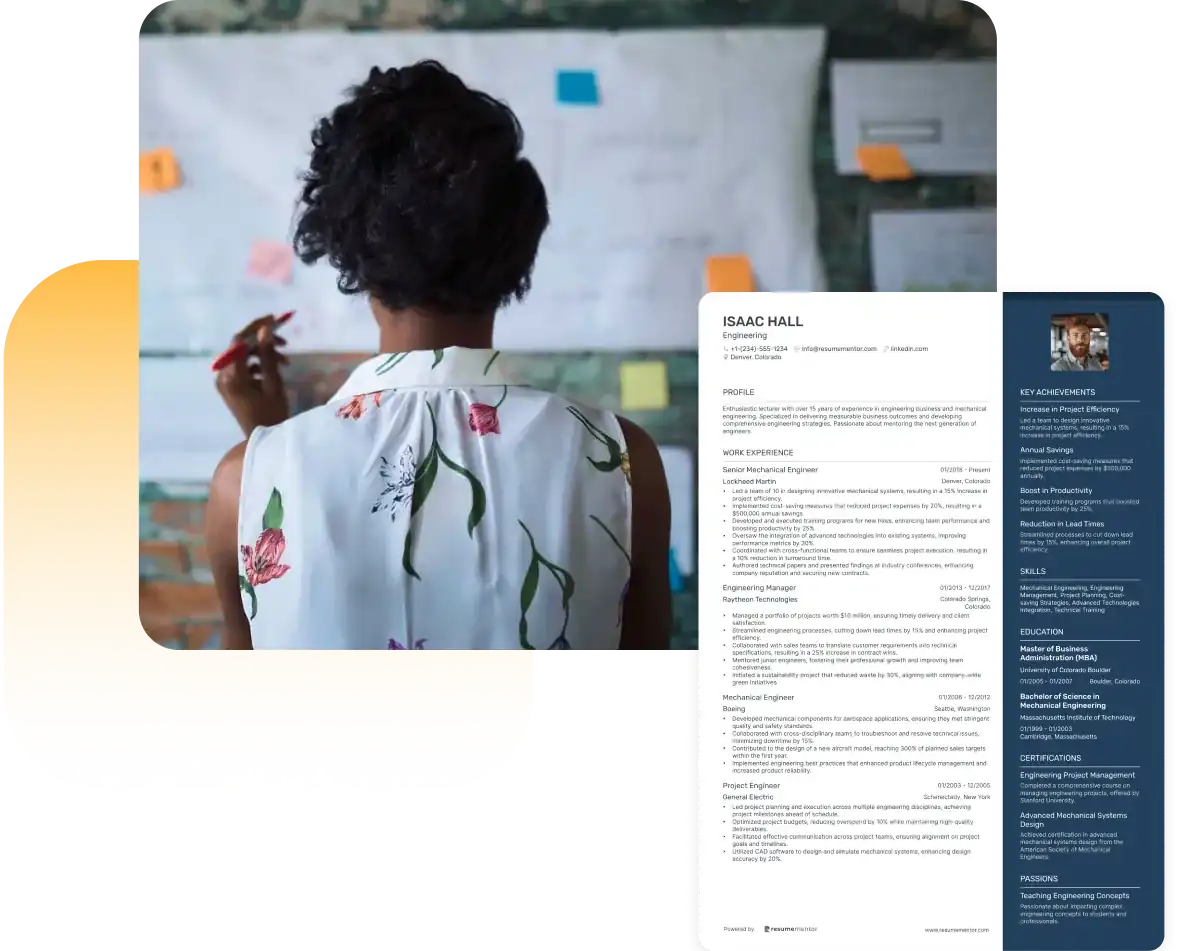
Continue Reading
Check more recommended readings to get the job of your dreams.
Resume
Resources
Tools
© 2025. All rights reserved.
Made with love by people who care.

